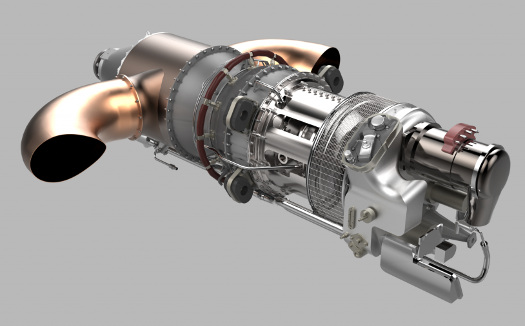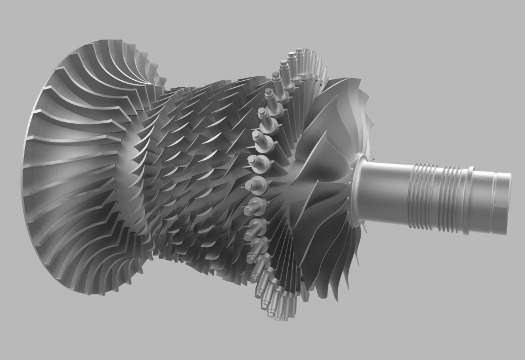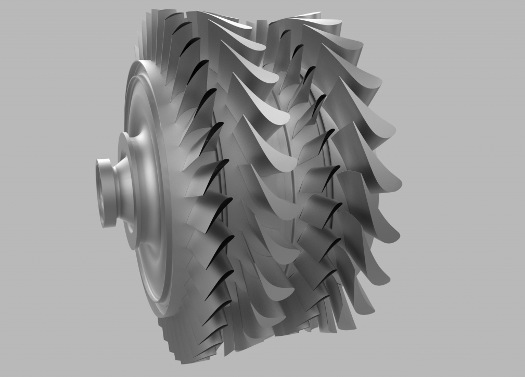 |
| November 24, 2015 | Volume 11 Issue 44 |
Designfax weekly eMagazine
Archives
Partners
Manufacturing Center
Product Spotlight
Modern Applications News
Metalworking Ideas For
Today's Job Shops
Tooling and Production
Strategies for large
metalworking plants
Wings:
GE advanced turboprop engine reaches new heights
By Matt Benvie, GE Reports

GE's new turboprop engine is the same size as its peers but produces nearly double the overall pressure ratio. [Image credit: GE Aviation]
Textron Aviation, the world's largest maker of business propeller planes like Beechcraft Bonanza, Baron, and King Air, said Nov. 16 it would use a brand new advanced turboprop engine developed by GE to power its latest single-engine turboprop plane. The engine burns 20 percent less fuel and produces 10 percent more power, compared to engines in its class.
The agreement represents a major coup for GE Aviation. A mainstay in the commercial and military jet engine space, the company entered the turboprop space for business aviation only seven years ago, when Pratt & Whitney Canada dominated the market.
The new turboprop engine is the same size as its peers but produces nearly double the overall pressure ratio. It will allow pilots to carry less fuel for the same mission, said Brad Mottier, vice president of business and general aviation and integrated systems at GE Aviation. "They can fly longer distances with more power while enjoying jet-like operational smoothness in the cockpit," Mottier, who himself is a pilot, said. "That's because the engine and propeller controls eliminate worries like over-temperature and over-torqueing. These technologies are unprecedented in turboprops, so now Textron Aviation can design a different class of aircraft."
Textron Aviation, which also owns the Cessna, Hawker, and Bell Helicopter brands, helped launch a new class in business aviation in 1964 with Beechcraft King Air powered by Pratt & Whitney's PT6 engine. The engine remains the best-selling turboprop on the market today.
That could change.
"Our single engine turboprop will combine the best of both clean-sheet aircraft and new engine designs, " Christi Tannahill, senior vice president for turboprops and interior design at Textron Aviation, said about the new plane. "By leveraging the newest technologies, we expect our single-engine turboprop to outperform the competition in critical areas ranging from cabin size and acquisition cost to performance capability and fuel savings."

In 2008, Mottier, who himself is a pilot, launched GE's Business and General Aviation unit. [Image credit: GE Aviation]
To develop the new engine, GE pulled together jet technologies that have logged more than 1 billion flight-hours, but have never been used inside a turboprop of this size. GE calls this idea of sharing technologies and knowledge "the GE Store."
For example, the engine's designer drew on a technology called variable stator vanes. It was originally developed by GE engineer and aviation legend Gerhard Neumann for supersonic flight, but now it also serves inside GE's largest and most efficient gas turbines. The new engine will also include 3D-printed parts, which debuted inside the LEAP jet engine, cooled turbine blades, and integrated propulsion control that manages both the engine and propeller as a single system to lessen pilot workload.

A rendition of the new engine's compressor. [Image credit: GE Aviation]
Mottier said that, packaged together, the new technologies will improve aircraft performance and can extend time between engine overhauls by more than 30 percent.
The new 1,300 shaft-horsepower (SHP) turboprop will be GE's first engine designed, tested, and manufactured in Europe. GE will open a new "turboprop center of excellence" to make the engine as well as new regional aircraft engines. "We plan to select a location for the new turboprop center of excellence in Europe by the end of the first quarter in 2016," Mottier said.

GE started building small turboprop engines in 2008 when it acquired Walter Aircraft Engines in the Czech Republic. At the time, Walter produced a small number of simple yet rugged turboprops utilized mostly in Eastern Bloc nations, Russia, and parts of Africa.
GE re-designed the engines so they could produce as much as 850 hp, fly higher, and consume less fuel to reach some of the world's most remote airports, including Lukla at the foot of Mt. Everest. They also serve on commuter and business planes as well as crop dusters.
When Mottier launched GE's Business and General Aviation unit in 2008, the group's annual revenues, driven primarily by the CF34 engines on the Challenger jet, were less than $100 million.
GE's business aircraft engine portfolio now includes engines for the HondaJet through its joint venture, called GE Honda. GE is also developing the Passport engine for Bombardier's Global 7000 and Global 8000 aircrafts. GE expects revenue from the core business and general aviation business to top $1 billion in 2020.
But now with the Textron Aviation selection, Mottier said GE has secured a platform that is worth "billions" in revenue on its own.
"For business and general aviation turboprops, today's selection is similar in magnitude to the CFM-Pratt & Whitney battle to power commercial narrow-body jets in the late 1960s," Mottier said. CFM is a 50/50 joint company between GE Aviation and France's Safran (Snecma).
"Four decades ago, the Pratt & Whitney JT8D was the dominant engine in commercial aviation. Then, CFM came to the table with new technologies and a higher bypass ratio engine, and displaced the JT8D," Mottier said. "Some 28,000 engines later, the rest is history. I think there's a parallel here when you think about our new advanced turboprop, breaking into a market where Pratt & Whitney Canada has sold more than 41,000 engines over the past 50 years. This is by far the biggest win of my 35-year career in aviation."
Read more GE Reports at www.gereports.com.
Published November 2015
Rate this article
View our terms of use and privacy policy
